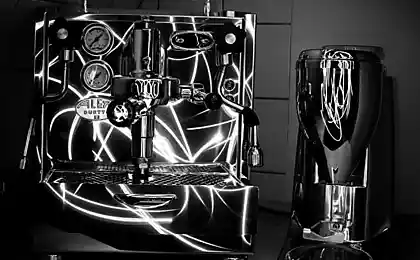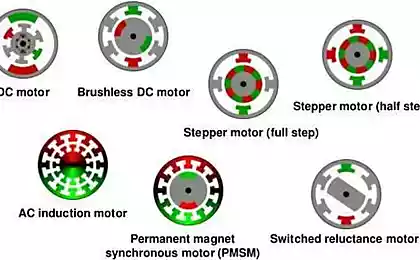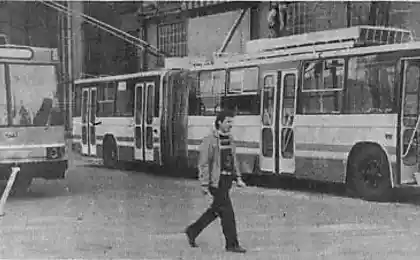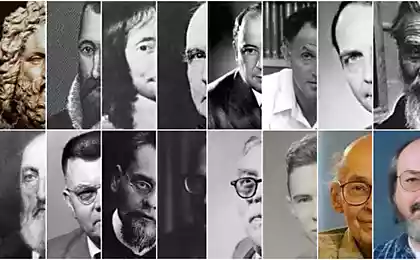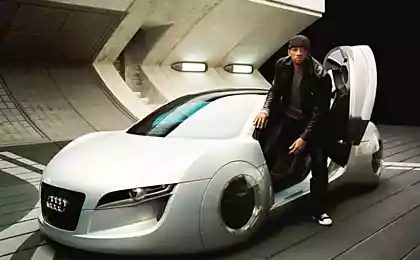1902
Steam engines
All the world's corporations are preparing to start mass production of electric vehicles, which should replace the smelly cars with internal combustion engines. But in addition to electricity and benzo engine, humanity knows steam engines and know them for several centuries. About these unjustly neglected companion who we are today and we'll talk. The first steam engine
19th century? And maybe in the 18th century it created the first steam engine? Do not guess, do not guess. In the first century BC, that is, more than 2 thousand years ago, a Greek engineer Hero of Alexandria was the first in the history of mankind steam engine.
The engine is a sphere which rotates about its axis under the influence of steam escaping from it. However, the Greeks hardly understand the essence of the process, so the development of this technology stopped almost 1500 years ...

Steam toy Emperor
Ferdinand Verbst, a member of the Jesuit community in China, built the first steam car on the move about in 1672 as a toy for the Chinese Emperor. The car was small and could not take the driver or passenger, but perhaps it was the first working steam vehicles ("car"). But it was the first paromobil in history, albeit a toy.
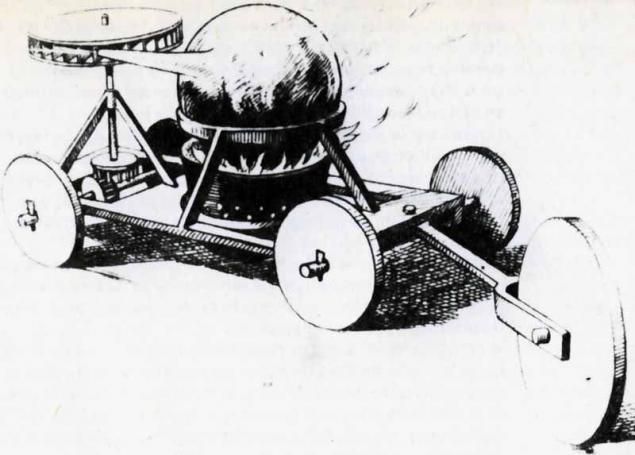
Project Newton
Famous Scientists have also considered the idea of "ride" the power of steam and create a self-propelled carriage. One known such projects was the crew of Isaac Newton. The crew presented himself as the cart is equipped with a steam boiler with a nozzle through which a valve driver could play off steam, thereby dispelling the cart. But the great scientist did not realize his project, paromobil Newton remained on paper.

Nyukmen Thomas and his car by pumping out groundwater
The first device, applied in practice, became the engine Nyukmena. Briton Thomas Nyukmen constructed a steam engine, which was similar to modern engines. The cylinder and the piston, which moved it under the influence of steam pressure. The steam produced in the boiler of great size, which is not allowed to use this machine as otherwise the machine for pumping groundwater.
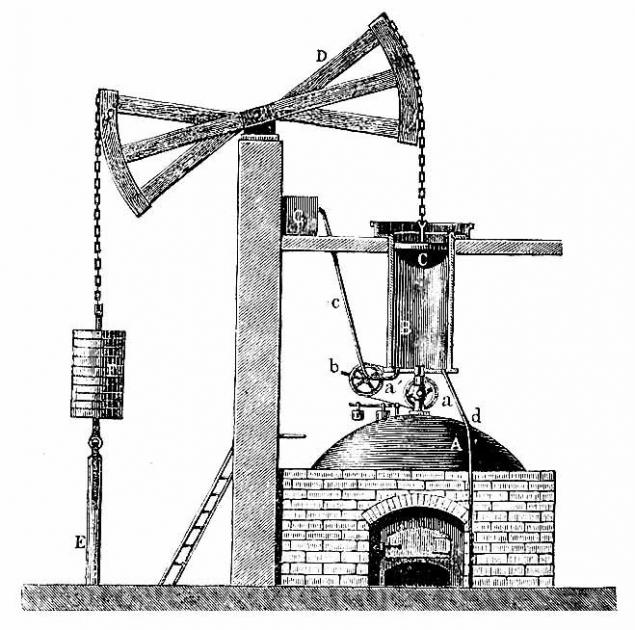
James Watt
Scotsman James Watt took the car to improve Nyuksmena. He noted that to reduce the consumption of coal is necessary to constantly maintain a high temperature in the cylinder, and also adjusted the machine to the condenser where it was going to exhaust steam, which is subsequently converted into the water and with the help of pump back to the boiler. All this would put the engine to the frame and create the first paromobil but Watt held a dangerous form of transport and did not develop further. Moreover, the designer received a patent for his machine, which has become an obstacle for other designers to work on the first paromobiley.

Still not a car, but the cart
Creator of the first self-propelled vehicle was Frenchman Nicolas Joseph Cugnot,. In 1769, the inventor has created a three-wheeled wagon - "small cart Cugnot", also called "Farda". According to the authors, this is a strange vehicle was used to carry guns. Still not a car, but a self-propelled cart.
Only wagon Cugnot had a lot of shortcomings. Motor weight was about a ton, so the cart barely managed two people. Another disadvantage of the small carts Cugnot was low range - only one kilometer. Refueling in the form of water in the boiler, campfire on the road, where the boiler is transferred, were too long and complicated procedure. Speed also wanted to be better, only 4 km / h.
But there were carts and dignity. Capacity amounted to two tons, which is very pleasant to the generals of the French staff, who identified Kyunyu 20,000 francs for further work on the cart.
The funds Designer usefully applied, and the second version of the cart has moved at a speed of 5-7 kilometers per hour, and installed under the boiler furnace allowed to keep the temperature on the go and do not stop every 15 minutes to fuel the fire.
This embryo of the future of the car made the first in the history of road accidents. At the wheel of the cart jammed and she rammed a wall of the house.
Despite the success of Cugnot, work was suspended for the banal reason: the money ran out. But our joy cart French designer still preserved and we can see it firsthand.
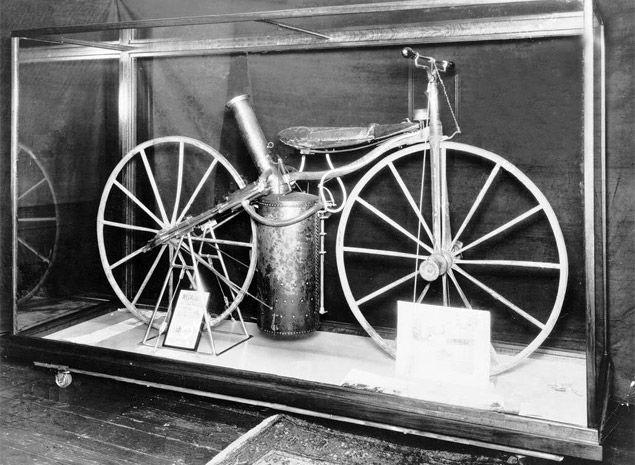

Roper steam bike
The inventors were in constant search. If Cugnot was moving towards the creation of the car, the American Sylvester Howard Roper took to create the future bike. It would be better to say the steam bike.
Roper placed under the seat of the steam engine, the output of the pair carried out directly behind the seat. The speed is controlled with the switch on the steering wheel. Turn it away from you, the driver increased speed, turning in the opposite direction to brake.
Travel Roper on the first bike caused shock and outrage surrounding, well, just as we are indignant noisy motorcycles. In Roper even complained to the police. Inventor saved from prison and a fine only the absence of a law that would prohibit driving on the right bike.
And it is as modern bikers, Roper, driving on his steam bike crashed.
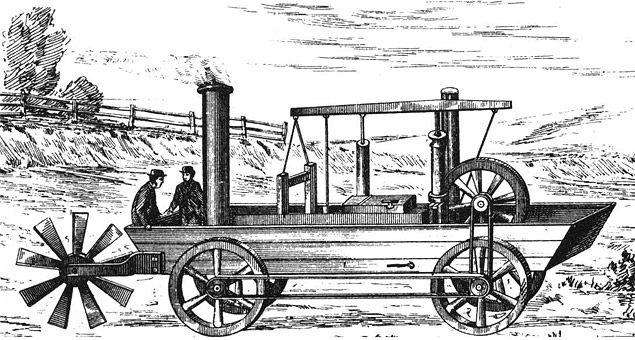
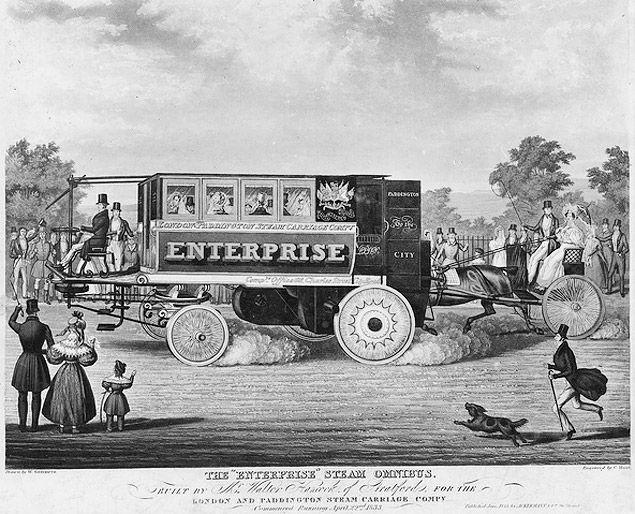

Steam amphibious
Oruktor Amphibolos, the first amphibious vehicle was developed in 1804, American inventor Oliver Evans. On the body in the form of boats were equipped with 4-wheel drive and paddle wheel at the stern. It was a giant machine-nine meters long and weight 15 tons.
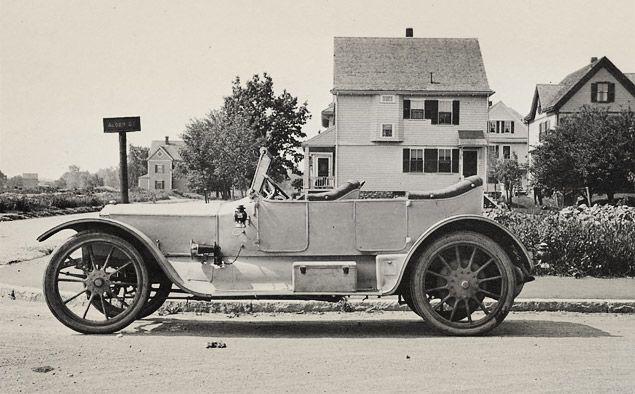
Omnibus Enterprise
The disadvantage of the first steam engines were low load and low speed. Horse carts (omnibuses) were faster than the fastest steam engine. Engineers came to grips with the horsepower.
The first car designed for eight people Richard Trevithick. But the car Richard was not interested investors. Thirty years later, Walter Hancock took over and created the first steam omnibus, called Enterprise. A ton of water, two-cylinder engine, the speed of 32 kilometers per hour and a range of up to 32 kilometers. It is even possible to use Enterprisekak commercial vehicles. And it has been successful inventors - went through the streets of the first bus.
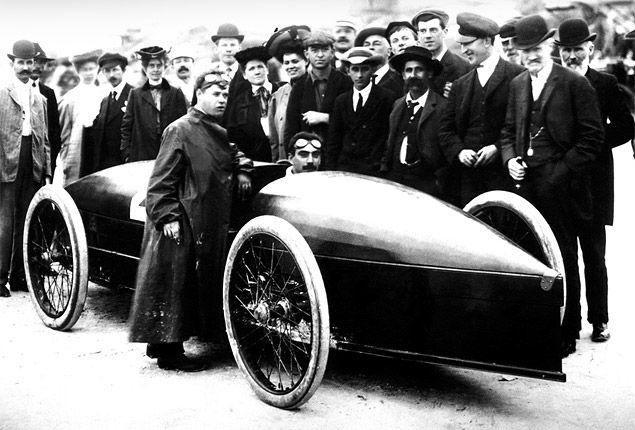
The first machine
The first steam engine, which was not similar to the trolley with a pan and a regular car, was constructed by brothers John and Abner Doble. The car had already Doble many familiar components, but for later.
While still a student Abner began in 1910 in the development of steam engines in his own workshop. What did the brothers, since this is to reduce the volume of water. As you remember, in the Enterprise used a ton of water. Model Doble 90 liters had a range of up to one and a half thousand kilometers. His brothers, the inventors of the machine equipped with an automatic ignition system. That today we are turning the key strike sparks in the engine. Ignition system Doble kerosene is injected into the carburetor, where it is ignited and fed into the chamber under the boiler. The required pressure of water vapor created for a record at the time of 90 seconds. 1, 5 minutes and you can get under way. You say a long time, but steam engines other constructors touched in 10 or even 30 minutes.

Exposed sample machine to peck at the show in New York, caused a furore. Only during the exhibition brothers gathered orders for 5,500 cars. But then the First World War, caused the crisis and the lack of metal in the country, and the production had to forget.
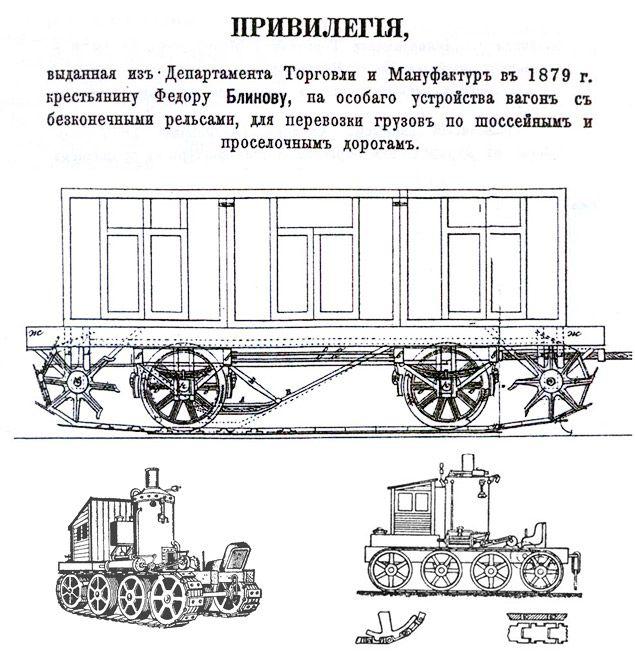
After the war, Doble presented to the public opinion of new and improved model of a steam car. The necessary pressure in the boiler was achieved after 23 seconds, the speed of 160 kilometers per hour, and 10 seconds, the car accelerated to 120 kilometers per hour. The only perhaps disadvantage of the car was its price. Unrealistic for those ages 18 thousand dollars. Paromobil greatest in human history, it was released in quantities of 50 copies.
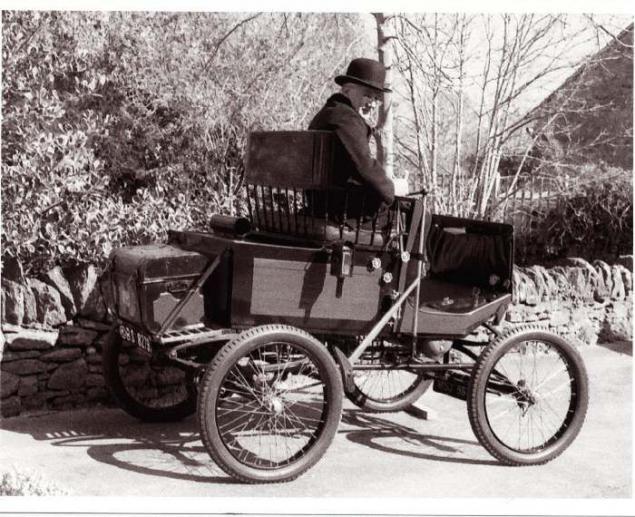
Faster couple
Again brothers inventors, this time Stanley brothers, set about creating the car in a boiling water. Their race car was ready for the arrival in 1906. On Florida Beaches car accelerated to 205 kilometers per hour 4. At that time, it was an absolute record, even for cars with petrol engine. Here you have the pot on wheels.
Brothers only injury stopped one of them resulting from an accident at parobolide. Speed record car brothers Stanley was second to none more than a century.
--img16--
Inspiration
The next speed record was set Aug. 26, 2009 car Inspiration. The car, more like a fighter, powered by a twin-turbo, which is rotated by a couple, pressurized to 40 bar of the twelve high-performance boilers. Under the hood of this device is hidden 360 horsepower, which allows you to accelerate to 225 kilometers per hour.
--img17--
ParoRossiya
Steam cars, of course, could not pass by Russia. The first coal-fired and domestic water model in 1830 would be a "Bystrokat" Casimir Yankevich. According to calculations, this designer paromashina could accelerate to a speed of 32 kilometers per hour. But the car has remained on paper.
First paromashinu created by the talented Russian peasant Fyodor Blinov. In 1879, he received a patent for "a special device on the car with endless rails for the carriage of goods by road and dirt tracks." Later, the car turned into a track steam tractor that taught Blinov also rotated due to the difference in torque on each of the tracks. But the child did not appreciate the inventor, issued only a slight premium.
--img18--
The first Russian paromobili began to produce at a Moscow factory "Dux". Those who collects vintage models know this nifty machine "Locomobile».
--img19--
"Cars did not make noise, which still can not be said about gasoline. Even electric vehicles driven by electricity, this power of the future, noise (rather hum) over paromobili "Dux". His whole mechanism is so simple and compact, which is placed under the seat and does not require for its placing no protruding parts, such as the nose benzomobiley has no change gears, electric batteries, magnetos, easily broken candles, in a word, everything, that is the cause of most breakdowns and trouble from gasoline vehicles, "- wrote in the beginning of the last century the magazine" Car ».
Rapidly developing internal combustion engines running on gasoline, put an end to the development paromobiley. The inventors tried to revive this technology, but their ideas were not supported.
--img20--
Source:
19th century? And maybe in the 18th century it created the first steam engine? Do not guess, do not guess. In the first century BC, that is, more than 2 thousand years ago, a Greek engineer Hero of Alexandria was the first in the history of mankind steam engine.
The engine is a sphere which rotates about its axis under the influence of steam escaping from it. However, the Greeks hardly understand the essence of the process, so the development of this technology stopped almost 1500 years ...

Steam toy Emperor
Ferdinand Verbst, a member of the Jesuit community in China, built the first steam car on the move about in 1672 as a toy for the Chinese Emperor. The car was small and could not take the driver or passenger, but perhaps it was the first working steam vehicles ("car"). But it was the first paromobil in history, albeit a toy.

Project Newton
Famous Scientists have also considered the idea of "ride" the power of steam and create a self-propelled carriage. One known such projects was the crew of Isaac Newton. The crew presented himself as the cart is equipped with a steam boiler with a nozzle through which a valve driver could play off steam, thereby dispelling the cart. But the great scientist did not realize his project, paromobil Newton remained on paper.

Nyukmen Thomas and his car by pumping out groundwater
The first device, applied in practice, became the engine Nyukmena. Briton Thomas Nyukmen constructed a steam engine, which was similar to modern engines. The cylinder and the piston, which moved it under the influence of steam pressure. The steam produced in the boiler of great size, which is not allowed to use this machine as otherwise the machine for pumping groundwater.

James Watt
Scotsman James Watt took the car to improve Nyuksmena. He noted that to reduce the consumption of coal is necessary to constantly maintain a high temperature in the cylinder, and also adjusted the machine to the condenser where it was going to exhaust steam, which is subsequently converted into the water and with the help of pump back to the boiler. All this would put the engine to the frame and create the first paromobil but Watt held a dangerous form of transport and did not develop further. Moreover, the designer received a patent for his machine, which has become an obstacle for other designers to work on the first paromobiley.

Still not a car, but the cart
Creator of the first self-propelled vehicle was Frenchman Nicolas Joseph Cugnot,. In 1769, the inventor has created a three-wheeled wagon - "small cart Cugnot", also called "Farda". According to the authors, this is a strange vehicle was used to carry guns. Still not a car, but a self-propelled cart.
Only wagon Cugnot had a lot of shortcomings. Motor weight was about a ton, so the cart barely managed two people. Another disadvantage of the small carts Cugnot was low range - only one kilometer. Refueling in the form of water in the boiler, campfire on the road, where the boiler is transferred, were too long and complicated procedure. Speed also wanted to be better, only 4 km / h.
But there were carts and dignity. Capacity amounted to two tons, which is very pleasant to the generals of the French staff, who identified Kyunyu 20,000 francs for further work on the cart.
The funds Designer usefully applied, and the second version of the cart has moved at a speed of 5-7 kilometers per hour, and installed under the boiler furnace allowed to keep the temperature on the go and do not stop every 15 minutes to fuel the fire.
This embryo of the future of the car made the first in the history of road accidents. At the wheel of the cart jammed and she rammed a wall of the house.
Despite the success of Cugnot, work was suspended for the banal reason: the money ran out. But our joy cart French designer still preserved and we can see it firsthand.


Roper steam bike
The inventors were in constant search. If Cugnot was moving towards the creation of the car, the American Sylvester Howard Roper took to create the future bike. It would be better to say the steam bike.
Roper placed under the seat of the steam engine, the output of the pair carried out directly behind the seat. The speed is controlled with the switch on the steering wheel. Turn it away from you, the driver increased speed, turning in the opposite direction to brake.
Travel Roper on the first bike caused shock and outrage surrounding, well, just as we are indignant noisy motorcycles. In Roper even complained to the police. Inventor saved from prison and a fine only the absence of a law that would prohibit driving on the right bike.
And it is as modern bikers, Roper, driving on his steam bike crashed.



Steam amphibious
Oruktor Amphibolos, the first amphibious vehicle was developed in 1804, American inventor Oliver Evans. On the body in the form of boats were equipped with 4-wheel drive and paddle wheel at the stern. It was a giant machine-nine meters long and weight 15 tons.

Omnibus Enterprise
The disadvantage of the first steam engines were low load and low speed. Horse carts (omnibuses) were faster than the fastest steam engine. Engineers came to grips with the horsepower.
The first car designed for eight people Richard Trevithick. But the car Richard was not interested investors. Thirty years later, Walter Hancock took over and created the first steam omnibus, called Enterprise. A ton of water, two-cylinder engine, the speed of 32 kilometers per hour and a range of up to 32 kilometers. It is even possible to use Enterprisekak commercial vehicles. And it has been successful inventors - went through the streets of the first bus.

The first machine
The first steam engine, which was not similar to the trolley with a pan and a regular car, was constructed by brothers John and Abner Doble. The car had already Doble many familiar components, but for later.
While still a student Abner began in 1910 in the development of steam engines in his own workshop. What did the brothers, since this is to reduce the volume of water. As you remember, in the Enterprise used a ton of water. Model Doble 90 liters had a range of up to one and a half thousand kilometers. His brothers, the inventors of the machine equipped with an automatic ignition system. That today we are turning the key strike sparks in the engine. Ignition system Doble kerosene is injected into the carburetor, where it is ignited and fed into the chamber under the boiler. The required pressure of water vapor created for a record at the time of 90 seconds. 1, 5 minutes and you can get under way. You say a long time, but steam engines other constructors touched in 10 or even 30 minutes.

Exposed sample machine to peck at the show in New York, caused a furore. Only during the exhibition brothers gathered orders for 5,500 cars. But then the First World War, caused the crisis and the lack of metal in the country, and the production had to forget.

After the war, Doble presented to the public opinion of new and improved model of a steam car. The necessary pressure in the boiler was achieved after 23 seconds, the speed of 160 kilometers per hour, and 10 seconds, the car accelerated to 120 kilometers per hour. The only perhaps disadvantage of the car was its price. Unrealistic for those ages 18 thousand dollars. Paromobil greatest in human history, it was released in quantities of 50 copies.

Faster couple
Again brothers inventors, this time Stanley brothers, set about creating the car in a boiling water. Their race car was ready for the arrival in 1906. On Florida Beaches car accelerated to 205 kilometers per hour 4. At that time, it was an absolute record, even for cars with petrol engine. Here you have the pot on wheels.
Brothers only injury stopped one of them resulting from an accident at parobolide. Speed record car brothers Stanley was second to none more than a century.
--img16--
Inspiration
The next speed record was set Aug. 26, 2009 car Inspiration. The car, more like a fighter, powered by a twin-turbo, which is rotated by a couple, pressurized to 40 bar of the twelve high-performance boilers. Under the hood of this device is hidden 360 horsepower, which allows you to accelerate to 225 kilometers per hour.
--img17--
ParoRossiya
Steam cars, of course, could not pass by Russia. The first coal-fired and domestic water model in 1830 would be a "Bystrokat" Casimir Yankevich. According to calculations, this designer paromashina could accelerate to a speed of 32 kilometers per hour. But the car has remained on paper.
First paromashinu created by the talented Russian peasant Fyodor Blinov. In 1879, he received a patent for "a special device on the car with endless rails for the carriage of goods by road and dirt tracks." Later, the car turned into a track steam tractor that taught Blinov also rotated due to the difference in torque on each of the tracks. But the child did not appreciate the inventor, issued only a slight premium.
--img18--
The first Russian paromobili began to produce at a Moscow factory "Dux". Those who collects vintage models know this nifty machine "Locomobile».
--img19--
"Cars did not make noise, which still can not be said about gasoline. Even electric vehicles driven by electricity, this power of the future, noise (rather hum) over paromobili "Dux". His whole mechanism is so simple and compact, which is placed under the seat and does not require for its placing no protruding parts, such as the nose benzomobiley has no change gears, electric batteries, magnetos, easily broken candles, in a word, everything, that is the cause of most breakdowns and trouble from gasoline vehicles, "- wrote in the beginning of the last century the magazine" Car ».
Rapidly developing internal combustion engines running on gasoline, put an end to the development paromobiley. The inventors tried to revive this technology, but their ideas were not supported.
--img20--
Source:
